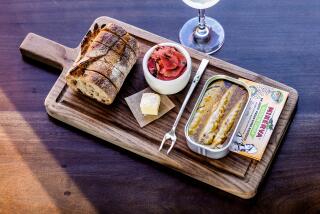Master Class: Michael Cimarusti on brined halibut
- Share via
The cure for anything is salt water: sweat, tears or the sea.¿
—Isak Dinesen
Salt is the one ingredient that every person has in his or her cupboard. If you are like me, you might have several varieties from various far-flung sources. I’ve got smoked salt, mined salt, salt from the peaks of the Himalayas and salt derived directly from the sea, including my three favorites, fleur de sel, Maldon salt and sel gris.
One of salt’s most miraculous attributes is its ability to preserve foods. Before refrigeration, our forebears were able to preserve their catch and “salt away” meats after the hunt. This kept them from starvation in lean times. Today we face no such hardships — hobbyists and doomsday preppers aside — so salt as a means of preservation is no longer a necessity.
Instead, let’s focus on the space between preservation and seasoning: brining. Brining is a simple process for which you need no special tools and few ingredients: salt, water and something to brine.
The brining of meats is common. Lots of people brine their Thanksgiving turkey. At Providence, we have taken to brining certain fishes. The one that has yielded the best results is Alaskan halibut. The technique also works with other white-fleshed fish and even salmon, but I especially like it with halibut, which has a certain reputation among cooks.
Halibut has many fans and just as many detractors, who are not wrong when they say that it is not the most flavorful fish. Because it is low in fat, halibut benefits from a little, ahem, “enhancement,” as it’s termed here in L.A. An hourlong dunk in a simple brine of salt and water is just the thing to transform halibut into the type of fish you always wished it could be.
Use a standard 5% brine. To prepare enough for six to eight portions of fish, start out with 50 grams of salt, 600 grams of water and 400 grams of ice. Whisk the salt into the water until it has dissolved before adding the ice. The ice ensures that the brine remains cold throughout the hour. By the way, I recommend using sea salt for the brine because it dissolves readily and has no anti-caking agents or additives. Either sel gris or Maldon will do.
Buy the halibut in large pieces that you can then cut into individual 5- to 6-ounce portions after the brining. This will help limit the salt absorption.
Once the hour has passed, remove the fish from the brine and rinse it briefly in an ice water bath or under a cold running tap. Dry the fish with paper towels. Finally, lay the fillets out on a sheet tray and place them in the refrigerator uncovered for at least four hours. Over that time the fish will dry and form a pellicle, or skin, which is comprised of proteins that create a sturdier portion of fish that is easier to handle and browns more readily.
When brined and properly cooked, the meat will break off into large, lovely translucent flakes. It will be juicy, seasoned through and through and unlike any halibut you’ve had.
Cimarusti is chef at Providence restaurant in Los Angeles, which has two Michelin stars.
More to Read
Eat your way across L.A.
Get our weekly Tasting Notes newsletter for reviews, news and more.
You may occasionally receive promotional content from the Los Angeles Times.










